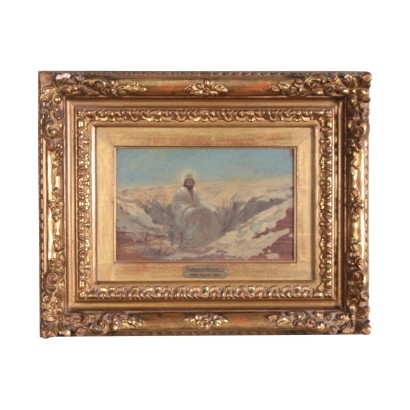Domenico Morelli - Arabic figure
Features
Artist: Domenico Morelli (1823-1901)
Artwork title: Figura araba
Age: 19th Century / 1801 - 1900
Subject: Oriental Subject
Artistic technique: Painting
Technical specification: Oil on Board
Description : Figura araba
Oil on panel. Signed in the lower right. On the back the stamp of the Galleria d'arte G. Cerruti in Milan. Domenico Morelli, a painter of naples, as well as the political of the new Kingdom of Italy (senator in the XVI legislature), he initially in the production of historical subjects die romantic; following contact with the macchiaioli and friendship with Filippo and Giuseppe Palizzi, came gradually to adopt a style less academic and more freely, especially in the use of color, creating a personal style that harmoniously combines the verismo and late-romanticism to models neoseicenteschi. From 1874 to 1883, and about, Domenico Morelli, painted pictures, having as subject scenes in the eastern, although never having been in those places, thus in the current of the Italian orientalists . The proposed work is presented in the frame of the end '800.
Product Condition:
Product in very good condition that may show slight traces of wear; may have undergone restoration work carried out by an expert.
Frame Size (cm):
Height: 41
Width: 51
Depth: 7
Artwork dimensions (cm):
Height: 18
Width: 28
Additional Information
Artist: Domenico Morelli (1823-1901)
Domenico Morelli, born in Naples in 1823, began attending the Academy of Fine Arts in Naples in 1836, a pupil of the painters Costanzo Angelini and Camillo Guerra, who educated him according to the principles of the most rigorous and cold academic style. His first paintings, affected by the teaching received, are of historical subjects, but, after the Academy, Domenico Morelli was influenced by the romantic ideal, with numerous medieval influences. After meeting other painters, including foreign ones, during his study trips, the young painter let himself be fascinated by the English poet Byron, starting the artistic journey that made him famous among his contemporaries, developing a rich theme with literary, religious and symbolic subjects . In 1848 he won a competition which allowed him to go to study in Rome where, involved in the 1848 uprisings for independence, he had the experience of prison. In 1855 he took part in the Universal Exhibition in Paris and, on his return to Florence, he took part in the debates of the Macchiaioli on pictorial realism at the Caffè Michelangiolo. From contact with the Macchiaioli and friendship with the painters Filippo and Giuseppe Palizzi, Morelli learned to appreciate all the artistic beauty of painting from life, which gradually led him to assume a less academic and freer style, above all in the use of color, creating his own personal style that harmoniously combines realism and late romanticism with neo-seventeenth-century models. Despite the hard study, he failed to get noticed until 1861, when he exhibited "The Iconoclasts" in Florence. In the following sixties Morelli finally became one of the best known Italian painters, appreciated for his exceptional qualities as a colourist and the dramatic effects he manages to instill in his painting. Appointed consultant of the Capodimonte Museum for the new acquisitions of works, he found himself among the exponents of southern society who worked in favor of the modernization of artistic institutions and the safeguarding of the local heritage. In 1868 Domenico Morelli obtained the teaching post at the Academy (where he had studied); in this period his interest was mainly focused on religious, mystical and supernatural themes; from this period is one of his most famous works, the "Assumption" of the Royal Palace of Naples. Because of his religiosity, he was one of the artists who collaborated on the illustrations of the Amsterdam Bible (1895) and, from 1899 until his death in Naples on August 13, 1901, he was director of the Academy of Fine Arts in Naples.
Age: 19th Century / 1801 - 1900
19th Century / 1801 - 1900
Subject: Oriental Subject
Artistic technique: Painting
La pittura è l'arte che consiste nell'applicare dei pigmenti a un supporto come la carta, la tela, la seta, la ceramica, il legno, il vetro o un muro. Essendo i pigmenti essenzialmente solidi, è necessario utilizzare un legante, che li porti a uno stadio liquido, più fluido o più denso, e un collante, che permetta l'adesione duratura al supporto. Chi dipinge è detto pittore o pittrice. Il risultato è un'immagine che, a seconda delle intenzioni dell'autore, esprime la sua percezione del mondo o una libera associazione di forme o un qualsiasi altro significato, a seconda della sua creatività, del suo gusto estetico e di quello della società di cui fa parte.
Technical specification: Oil on Board



















